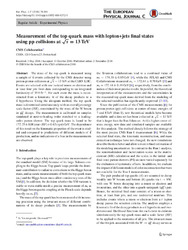Measurement of the top quark mass with lepton+jets final states using p p collisions at √s=13TeV
| dc.contributor.author | Sirunyan, A. M. | |
| dc.contributor.author | Işıldak, Bora | |
| dc.date.accessioned | 2019-03-25T11:25:02Z | |
| dc.date.available | 2019-03-25T11:25:02Z | |
| dc.date.issued | 2018-11 | |
| dc.identifier.issn | 1434-6044 | en_US |
| dc.identifier.uri | http://hdl.handle.net/10679/6211 | |
| dc.identifier.uri | https://link.springer.com/article/10.1140/epjc/s10052-018-6332-9 | |
| dc.description.abstract | The mass of the top quark is measured using a sample of t (t) over bar events collected by the CMS detector using proton-proton collisions at root s = 13 TeV at the CERN LHC. Events are selected with one isolated muon or electron and at least four jets from data corresponding to an integrated luminosity of 35.9 fb(-1). For each event the mass is reconstructed from a kinematic fit of the decay products to a t (t) over bar hypothesis. Using the ideogram method, the top quark mass is determined simultaneously with an overall jet energy scale factor (JSF), constrained by the mass of the W boson in q (q) over bar' decays. The measurement is calibrated on samples simulated at next-to-leading order matched to a leadingorder parton shower. The top quark mass is found to be 172.25 +/- 0.08 (stat+JSF)+/- 0.62 (syst) GeV. The dependence of this result on the kinematic properties of the event is studied and compared to predictions of different models of t (t) over bar production, and no indications of a bias in the measurements are observed. | en_US |
| dc.description.sponsorship | BMWFW and FWF (Austria); FNRS and FWO (Belgium); CNPq, CAPES, FAPERJ, and FAPESP (Brazil); MES (Bulgaria); CERN; CAS, MoST, and NSFC (China); COLCIENCIAS (Colombia); MSES and CSF (Croatia); RPF (Cyprus); SENESCYT (Ecuador); MoER, ERC IUT, and ERDF (Estonia); Academy of Finland, MEC, and HIP (Finland); CEA and CNRS/IN2P3 (France); BMBF, DFG, and HGF (Germany); GSRT (Greece); NKFIA (Hungary); DAE and DST (India); IPM (Iran); SFI (Ireland); INFN (Italy); MSIP and NRF (Republic of Korea); LAS (Lithuania); MOE and UM (Malaysia); BUAP, CINVESTAV, CONACYT, LNS, SEP, and UASLP-FAI (Mexico); MBIE (New Zealand); PAEC (Pakistan); MSHE and NSC (Poland); FCT (Portugal); JINR (Dubna); MON, RosAtom, RAS and RFBR (Russia); MESTD (Serbia); SEIDI, CPAN, PCTI and FEDER (Spain); Swiss Funding Agencies (Switzerland); MST (Taipei); ThEPCenter, IPST, STAR, and NSTDA (Thailand); TUBITAK and TAEK (Turkey); NASU and SFFR (Ukraine); STFC (United Kingdom); DOE and NSF (USA). Individuals have received support from the Marie-Curie program and the European Research Council and Horizon 2020 Grant, contract No. 675440 (European Union); the Leventis Foundation; the A. P. Sloan Foundation; the Alexander von Humboldt Foundation; the Belgian Federal Science Policy Office; the Fonds pour la Formation a la Recherche dans l'Industrie et dans l'Agriculture (FRIA-Belgium); the Agentschap voor Innovatie door Wetenschap en Technologie (IWT-Belgium); the F.R.S.-FNRS and FWO (Belgium) under the "Excellence of Science - EOS" - be.h project n. 30820817; the Ministry of Education, Youth and Sports (MEYS) of the Czech Republic; the Lendulet ("Momentum") Programme and the Janos Bolyai Research Scholarship of the Hungarian Academy of Sciences, the New National Excellence Program UNKP, the NKFIA Research Grants 123842, 123959, 124845, 124850 and 125105 (Hungary); the Council of Science and Industrial Research, India; the HOMING PLUS program of the Foundation for Polish Science, cofinanced from European Union, Regional Development Fund, the Mobility Plus program of the Ministry of Science and Higher Education, the National Science Center (Poland), contracts Harmonia 2014/14/M/ST2/00428, Opus 2014/13/B/ST2/02543, 2014/15/B/ST2/03998, and 2015/19/B/ST2/02861, Sonata-bis 2012/07/E/ST2/01406; the National Priorities Research Program by Qatar National Research Fund; the Programa Estatal de Fomento de la Investigacion Cientifica y Tecnica de Excelencia Maria de Maeztu, Grant MDM-2015-0509 and the Programa Severo Ochoa del Principado de Asturias; the Thalis and Aristeia programs cofinanced by EU-ESF and the Greek NSRF; the Rachadapisek Sompot Fund for Postdoctoral Fellowship, Chulalongkorn University and the Chulalongkorn Academic into Its 2nd Century Project Advancement Project (Thailand); theWelch Foundation, contract C-1845; and theWeston Havens Foundation (USA). | |
| dc.language.iso | eng | en_US |
| dc.publisher | Springer Nature | en_US |
| dc.relation.ispartof | The European Physical Journal C | |
| dc.rights | openAccess | |
| dc.title | Measurement of the top quark mass with lepton+jets final states using p p collisions at √s=13TeV | en_US |
| dc.type | Article | en_US |
| dc.description.version | Publisher version | en_US |
| dc.peerreviewed | yes | en_US |
| dc.publicationstatus | Published | en_US |
| dc.contributor.department | Özyeğin University | |
| dc.contributor.authorID | (ORCID 0000-0002-0283-5234 & YÖK ID 124605) Işıldak, Bora | |
| dc.contributor.ozuauthor | Işıldak, Bora | |
| dc.creator | The CMS Collaboration | |
| dc.identifier.volume | 78 | en_US |
| dc.identifier.issue | 11 | en_US |
| dc.identifier.wos | WOS:000459291000003 | |
| dc.identifier.doi | 10.1140/epjc/s10052-018-6332-9 | en_US |
| dc.identifier.scopus | SCOPUS:2-s2.0-85056078948 | |
| dc.contributor.authorMale | 1 | |
| dc.relation.publicationcategory | Article - International Refereed Journal - Institutional Academic Staff |
Files in this item
This item appears in the following Collection(s)
Share this page



